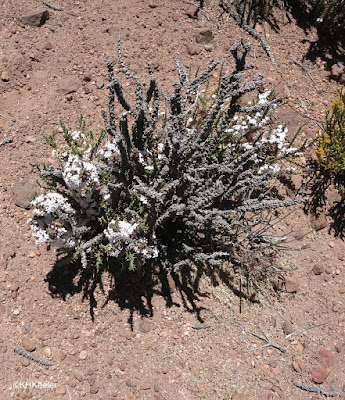The Atacama Desert is also high in elevation, over 7000', but quite far north in the Southern Hemisphere, meaning, near the tropics. The city of San Pedro de Atacama, where I stayed, is at just about exactly as far south of the Equator as Cabos San Lucas, Mexico, at the tip of Baja California, is north of it. The combination is bizarre to a central North American: elevation cools the temperatures, distance toward the equator warms them. The summer (January) highs around San Pedro de Atacama reach a maximum of 85 F and winter lows (in August) average just about freezing (32.1 F).
As you would expect with low humidity, the temperatures dropped quickly after sunset. I was expecting it to get cold but I only needed a light sweater.
There were in fact places where there was nothing for a botanist to look at:
But who would linger there?
Elsewhere it was much more interesting.
October is spring in the Atacama and like spring everywhere, plants were blooming. Indeed, I hit a good year, because in 2017 the summer rains near San Pedro were almost 3". Since 1.4-1.6" of rain is the annual average, I was there in the spring of a very wet year. (It is a quirky climate since the very limited moisture falls at the end of summer.)
Look!
 |
| Big cactus. See yellow flower at far upper left? |
 |
| Cactus flower closer up. |
I can't possibly show all the plants I saw in flower and photographed. It looked bleak but the plants--often in flower--were there! Some camouflaged, some quite small.
I have to emphasize the severity of the climate: it is warm most of the year but with virtually no water. Temperatures vary about 30 degrees F each day all year due to the low humidity. And, being at 7,000' above sea level with a low human population, the sunlight is intense--the area has some of the world's major telescopes because of the lack of stuff in the air. Herds of vicuñas and guanacos range free in the desert. To that people have added llamas, sheep and feral donkeys. Not only is it hard for plants to grow, they are likely to be eaten by hungry animals.
Despite all that going against them, the plants were a delight!
The plant above was really hard to spot: gray green leaves covered in dust. But there is a bud and a half-open pale yellow flower. I believe it is yerba santa, Pachylaeana atriplicifolia, with a daisy-like yellow flower (Asteraceae) (link).
Below, the plant is one of a group of succulents the locals called patas de guanaco (legs of the guanaco), genus Cisthanthe. I know I saw several species. Across the Americas there are about 38 species. The 11 species in North American deserts are often called pussypaws. The guides called teh ones I saw básal or wasal, making it Cistanthe celestoides (see pictures online link. Portulaca family, Portulacaceae).
 |
| básal Cistanthe celestoides |
 |
| Hoffmannseggia |
 |
| Lupines in the Atacama |
Only a few places had the lupines: not only do they wait for the right conditions to bloom, they are picky about where they grow. I only saw them a few times as we drove miles across the Atacama to visit geysers or salt flats, but when I did, they were flowering in the thousands.
Most places, landscape looked only vaguely green. But often when you got close, lots of things were in flower. This photo was taken as I returned to the van after walking to the dense stand of lupines. Note the yellow cast to the plant on the left: it had lots of small yellow flowers, and the white one up ahead, small white flowers.
Here is one white-flowered plant in bloom. My photos and notes are not good enough to identify it.
Small flowers were the norm, so they were hard to spot at a distance. The more I looked, the more diversity I saw.
The Atacama landscapes looked drab, but were full of delightful surprises!
Comments and corrections welcome
Note: Spring (September, October) 2017 was a spectacular year for flowers across the Atacama: see these photos
Hüdepohl, G. 2017. Atacama Blooming. Atacamaphoto.com link Accessed 11/17/17.
S., Darel. no date given. The incredible desert flowers of Atacama. Babamail. link Accessed 11/17/17.
References
Belov, M. Chile Flora link
Haene, E. 2007. 100 Flores Argentinas. Editorial Albatros. Buenos Aires, Argentina
Riedemann, P., G. Aldunate and S. Teillier. 2016. 2nd ed. Flora Nativa de Valor Ornmental. Chile Zona Norte. Ediciones Jardín Botánico Chagual.
Simpson, B.B. and E. A. Ulibarri. 2006. A synopsis of the genus Hoffmannseggia (Leguminosae). Lundellia. 9: 7-33.
My thanks to guide Talia Moder.
Kathy Keeler, A Wandering Botanist
More at awanderingbotanist.com










Thank you. I was in San Pedro in October 2001. Your piece brought back my memories of an extraordinary place, rich in its way, so many wonderful sights.
ReplyDeleteThanks! Traveled through the area by bus in December 2016 but did not have a chance to botanize much along the way... Looked pretty desolate other than cacti from the window or whenever we stopped. Se more about me at the following websites www.botanyeveryday.com www.plantsandhealers.org
ReplyDeleteIs Cistanthe celosioides. :)
ReplyDelete